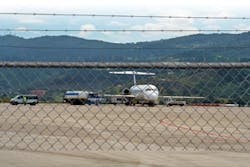Compliance Obstacles
As the industry closes in on compliance deadlines for a variety of rules and regulations, there are few options. We are all familiar with the ongoing focus on the electrification of GSE, however, not everything within the operating environment of a thriving air carrier, cargo transporter, ground handling provider or catering company can be converted. This leaves us all wondering: How can we comply with rules in the most cost-effective manner while not impeding our operational demands?
Many regulations, few solutions
Between the many rules now in effect in the state of California (PERP, LSI, LSI - FL and ORD pending), and in an effort to maintain compliance for previous rules and voluntary memorandums of understanding (MOUs), as well as the interim goals set by independent airport port authorities, the means for achieving all goals and deadlines is increasingly more difficult. For global carriers and operators the strategy to comply is as unique as each operator themselves. How each group and organization will reach the goals set forth will vary by many factors within the styles of services they offer. Regardless of the operating market, one portion is consistent — the equipment needed. Whether it is gas, diesel, propane or electric; whether it is to push back an aircraft, load cargo, move freight in a warehouse, or support a catering operation, the same types of equipment are needed across the board.
The major contributors of emissions in GSE are NOx and PMs, especially in the older units and larger heavy side of the operation, such as pushback tractors, container loaders, ground power units, air conditioners, heavy duty forklifts, catering vehicles, etc. While a few OEMs have attempted to create or convert some of these types to electrics, none have truly been in a long standing operating environment to determine if they will be successful. This leaves the operating teams looking to the newer, cleaner burning gas and diesel engines for compliance. The two biggest challenges are available cash flow and production and availability of the new Tier III and Tier IV engines.
The engine OEMs were given very strict timelines for creating a newer generation of engines to assist in cleaning the environment. The timelines were built by groups and entities not necessarily familiar with the operating demands of the units, whether it is airline related, construction, locomotive or any other major operating group lumped into the new rules. For the rule makers, the biggest concern was to create a structured timeline for compliance that will drastically reduce the emissions over a short period of time.
Relying on the OEMs
As operators, the struggles for compliance go well beyond our means of control. The OEMs for the equipment and the engine manufacturers are the major drivers for compliance. There simply is not sufficient time to build a new engine, test for performance, put the engines into the varying applications for usage, test that for performance and then offer mass quantities to everyone. Although the engine manufacturers are meeting the aggressive schedule for having Tier III and potentially the new Tier IV engines available, the OEMs are left without options for adequately re-engineering equipment to provide to their customers. Production times for engines and the subsequent equipment are creating compliance obstacles for the operators. The bigger challenge for the airport operators is that even though a new piece of equipment is received with a new Tier III engine, due to a lack of time for the engine OEMs and equipment OEMs to collectively create the main unit, the units fail to support the operation. Although the airport operators are investing valuable dollars in complying in the sense that new equipment is in service and the older, dirty equipment is out, the demanding operation is not being supported and creates increased downtime while the nuisances between both OEMs are worked out.
Although the regulations have allowances for verified diesel emission controls and other approved aftermarket installations to help combat the process of compliance while engines are being manufactured, no VDECs have been proven to support the GSE fleets. This leaves few alternatives other than outright replacing the equipment over and over again to meet the requirements. Obviously, this is a very costly endeavor.
There have been a few organizations that have come forward with the offer of grant funds for assisting in the compliance with the rules. However, taking advantage of these funds comes with many strings attached, making it an unrealistic option. Carriers and equipment operators need flexibility to move the equipment around the system as needed for changing schedules and market demands. Having restrictions tied to equipment, such as not being able to move a piece of equipment bought with grant funds from its original location, make it nearly impossible and undesirable to use these funds.
Communication, a key factor
Back to the original question at hand: How do we, as airport operators, meet the compliance timelines? The way we have been doing it is by juggling many facets of our resources that affect the direct operational needs for ramp, cargo, mail, catering, warehousing and maintenance. We must determine the true amount of equipment needed to support all of this without compromising safety and operational needs, while staying within financial constraints. Any and all possibilities are considered as the final plans are determined and implemented. Given today’s operating environments, options are limited, reporting time is drawing near and we’re grasping at all viable alternatives to ensure compliance. The only way this will all truly be successful is to open the lines of communication across many OEMs of equipment, OEMs of engines, airport operators, maintenance personnel and other supporting groups to ensure that all complexities of the compliance are reviewed, plans established (in some respects) as an industry, while doing it in the most cost-effective manner for us all.
